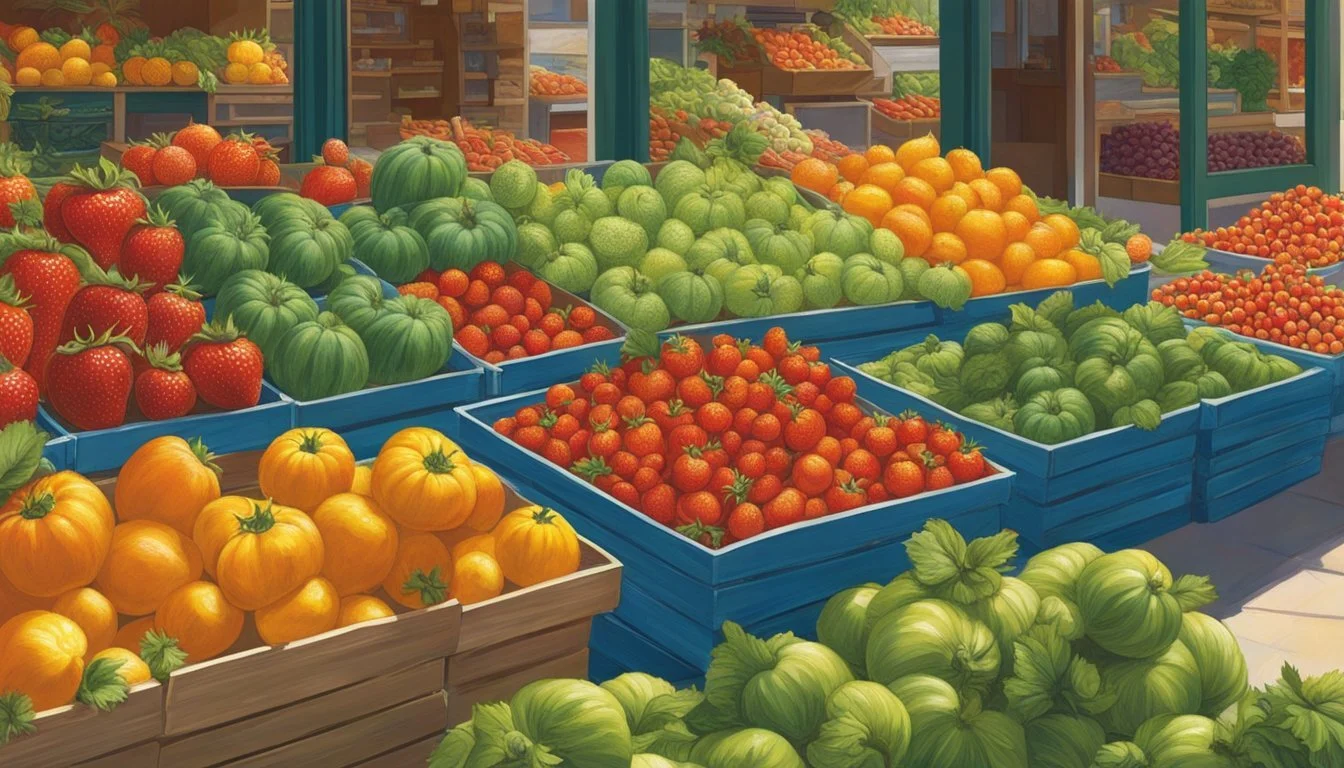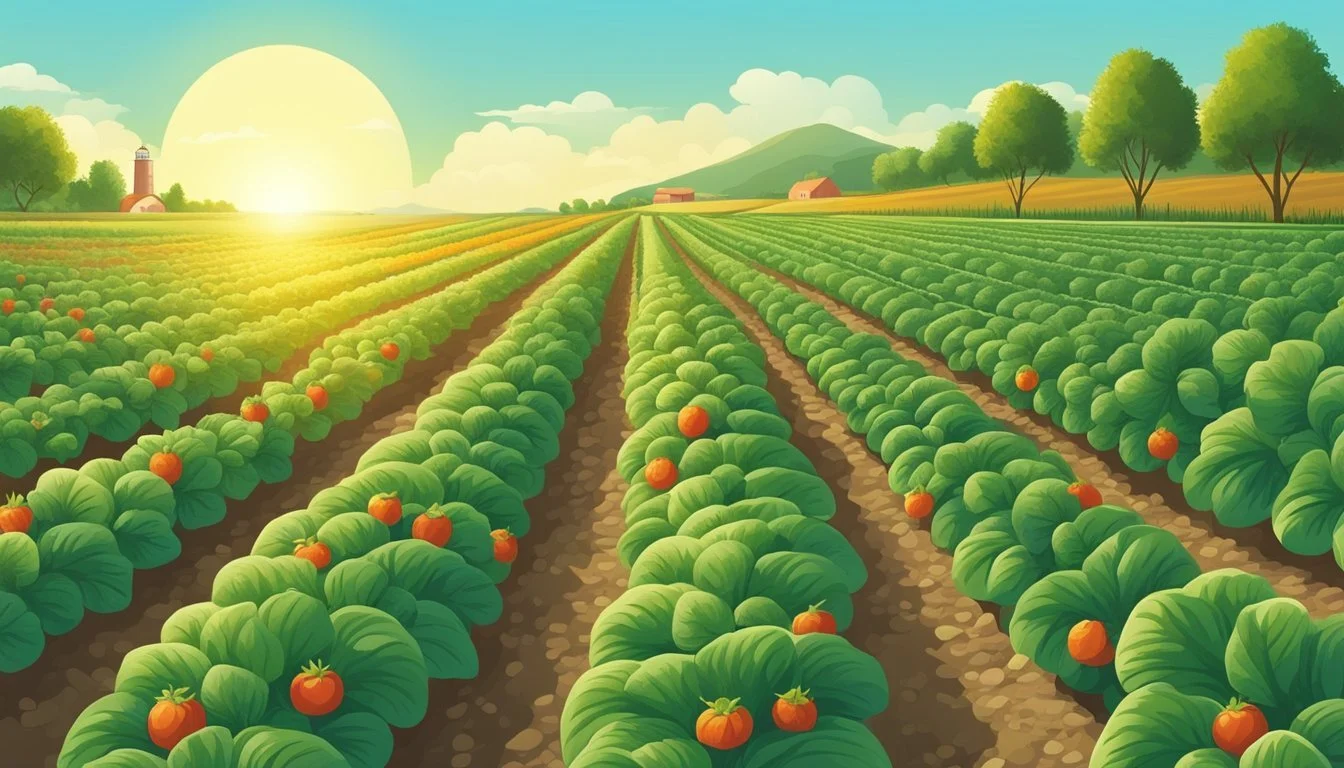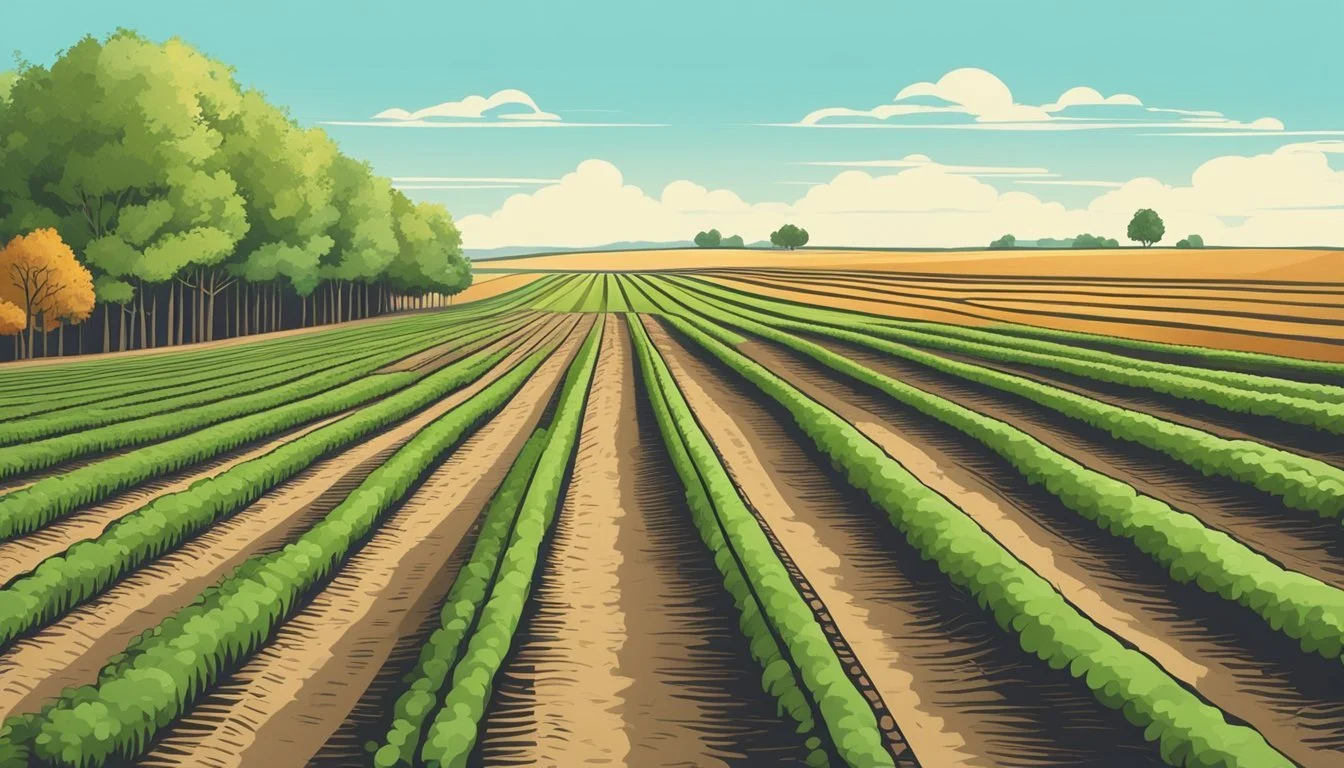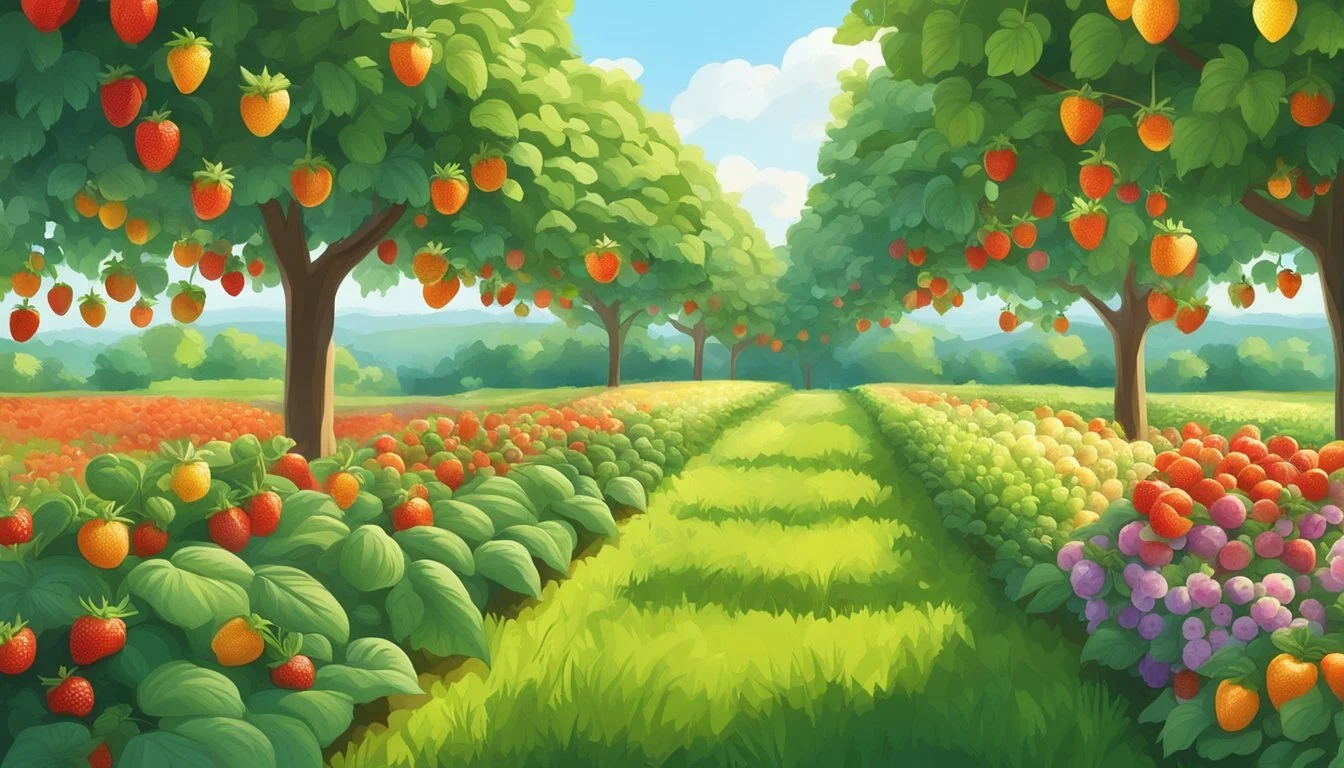Arkansas Seasonal Fruit & Vegetables in June
Your Guide to Fresh Produce
This Article is Part of our Arkansas Seasonal Fruit & Veg Calendar
In Arkansas, June is a thriving month for an abundance of fresh produce, offering a rich tapestry of flavors from the local farms and orchards. With the southern sun marking the commencement of summer, a variety of fruits and vegetables reach their peak, providing consumers with a cornucopia of fresh and nutritious options. Seasonality is key in Arkansas' agricultural calendar, ensuring that the produce not only tastes better but is also at its nutritional zenith and more environmentally friendly due to reduced transportation requirements.
Seasonal fruits in Arkansas during June include a selection of berries such as strawberries, blueberries, and blackberries, which are celebrated for their vibrant flavors and health benefits. These small fruits pack a punch with antioxidants and vitamins, and are often enjoyed fresh, in preserves, or baked into desserts. Melons begin to make an appearance as well, with the promise of juicy watermelons and cantaloupes (how long does cantaloupe last?) as the summer heat intensifies.
The vegetable assortment is equally impressive, as June welcomes the harvest of summer staples like cucumbers, tomatoes, and sweet corn. These vegetables are not only staples in Arkansas cuisine but also pivotal to local farming. Additionally, zucchinis, summer squash, and a variety of peppers turn the Arkansas fields into a painter's palette of greens, yellows, and reds. The fresh green beans and okra offer crunchy, flavorful additions to any dish, embodying the essence of southern cooking.
Understanding Arkansas' Growing Season
Arkansas' growing season is characterized by its varied climate and distinct hardiness zones, which significantly influence gardening activities and crop selection throughout the year.
Climate and Hardiness Zones
Arkansas experiences a humid subtropical climate that features hot summers and mild winters. The state is mostly encompassed within three main hardiness zones:
Zone 6: Covers the northern part of Arkansas with winter temperatures as low as -10°F.
Zone 7: Encompasses the central region, experiencing minimum temperatures between 0°F and 10°F.
Zone 8: Found in the southern parts, where winter lows seldom drop below 10°F.
The state's diverse climate allows for a variety of fruits and vegetables to be grown, but understanding the specific zone is crucial for selecting the appropriate crops for each season.
Gardening Tips for June
June in Arkansas is the beginning of the summer season when gardeners should focus on:
Watering: Ensure plants receive adequate moisture, as June can be particularly hot and dry.
Soil: Maintain nutrient-rich soil with proper fertilization and mulching to combat the intense summer heat.
Pest Control: Be vigilant about pests that thrive in summer, implementing appropriate measures to protect crops.
Gardeners should pay attention to the local weather forecasts and adapt their gardening practices to the variations in temperature and rainfall typical of early summer.
Planting and Harvest Calendar
In June, Arkansas gardeners are typically busy with both planting and harvesting. Here is a brief overview of the planting and harvest calendar for June:
Vegetables to Plant in June:
Okra
Southern peas
Sweet potatoes
Vegetables and Fruits to Harvest in June:
Squash
Cucumbers
Blueberries
Tomatoes
Peaches
It is essential for gardeners to track their local planting dates and adhere to their region's specific planting guides, which can fluctuate slightly between the hardiness zones.
Summer Harvesting Guide
In June, Arkansas's summer heat ripens a variety of fruits and vegetables, presenting an ideal time for harvest. Gardeners and shoppers can look forward to fresh sweet corn, tomatoes, and more bounty during this month.
Fruits Ready in June
Peaches: Begin picking in early June; they should be firm and fragrant.
Blackberries: Harvest when berries are fully black and easily come off the stem.
Vegetables Peaking in June
Sweet Corn: Look for bright green, snugly wrapped husks and plump kernels.
Tomatoes: Harvest when evenly ripe and deep in color; they should give slightly to the touch.
Peppers: Pick when they reach desired color and size, depending on the variety.
Cucumbers: Best when firm and bright green; overripe if yellowing.
Eggplant (What wine goes well with eggplant?): Ready when skin is glossy and the fruit feels heavy for its size.
Squash: Harvest summer squash when small and tender for best flavor.
Fruit Focus for June
In June, Arkansas celebrates a sweet abundance of fruits, with berries and melons reaching their peak ripeness and stone fruits beginning to make their luscious debut.
Berries and Melons
In the early summer days of June, berries are at their prime in Arkansas.
Strawberries: These bright red gems are typically winding down but can still be found early in the month.
Blueberries: June marks the beginning of blueberry season offering sweet and tangy flavors.
Blackberries: Robust and juicy, blackberries are also a highlight and ripe for picking.
Raspberries: Though rarer, raspberries can sometimes be found and are a delicate treat.
The season for melons takes off as well:
Watermelon: Synonymous with summer, watermelons become available and are a refreshing choice.
Cantaloupe: These aromatic melons are just entering their optimal season.
Both categories offer not just delicious flavors but also important nutrients, with berries being high in antioxidants and melons providing hydration and vitamins.
Stone Fruits
Arkansas's stone fruit season begins to flourish in June with:
Peaches: These fuzzy fruits are starting to arrive at markets, promising juicy bites.
Nectarines: The smoother relatives of peaches, nectarines also make a much-anticipated entrance.
Together, these stone fruits signify the start of a flavorful journey that will continue to develop through the summer months. They're often celebrated for their versatility in dishes, from fresh salads to sweet desserts.
Vegetable Spotlight in June
June spells a bounty for vegetables in Arkansas, where one can expect to see a lush variety of both leafy greens and heartier vegetables fit for summer cultivation. The emphasis this month is on greens that can withstand the lingering coolness of spring as well as crops that thrive in the approaching warmth.
Leafy Greens and Root Vegetables
Leafy greens such as kale and lettuce are robust in June. With Arkansas's cooler fall months making these greens cold-hardy, planting in June allows a cycle of planting and harvesting that utilizes the remaining cool temperatures.
Kale: Known for its resilience and nutrient density, kale can be started in June for a continued harvest into the cooler months.
Lettuce: Varieties such as Butterhead and Boston excel in June; they require minimal maintenance and can grow even in light frosts.
Root vegetables like carrots, turnips, and mustard (how long does mustard last?) are also prime candidates for June planting. These vegetables can be sown directly into the ground.
Carrots: Thrive in the transition from spring to summer; they prefer the cooler start of June.
Turnips: Grow relatively quickly, making them a perfect choice for an early summer harvest.
Mustard: The plant is adaptable and can mature even in the cool of late spring.
Nightshades and Gourds
Nightshade vegetables begin to show their strength as the weather warms. Eggplants and okra enter their ideal growing period with the heat of the summer months.
Eggplants: These vegetables need warm soil and night temperatures, achievable as June progresses.
Okra: Prefers hotter conditions and is sown directly once the soil has thoroughly warmed up.
Gourds such as beans come to the fore, making the most of the warmer soil temperatures for germination and growth.
Beans: Both pole beans and snap beans perform well in the drier, warmer conditions that June brings. They are generally easy to grow and provide a plentiful yield.
Crops like corn, while not strictly within the gourd family, also hit their stride in June's changing climate. Corn requires warm soil for good germination, making it well-suited for mid to late June planting in Arkansas.
Corn: It excels in full sun and well-drained soil, maximizing its growth as temperatures rise.
Preventing and Managing Pests
In Arkansas, June brings a plethora of fresh fruits and vegetables to harvest. However, it's also a critical time for growers to implement robust pest management strategies, with an emphasis on identifying common pests and utilizing natural control techniques to maintain healthy crops without compromising the ecosystem.
Common Pests in Arkansas
Arkansas's warm climate in June is conducive for various pests, which threaten to undermine the quality and yield of seasonal produce. Key pests include:
Insects: such as the Japanese beetles that particularly enjoy feasting on berry crops and stone fruits, aphids that can be found sucking sap from a wide range of plants.
Mammals: like deer, rabbits, and squirrels that are attracted to the tender shoots of new plant growth and ripening fruits.
Disease: which can also pose a threat to plants, often exacerbated by the presence of certain insects.
To mitigate these issues:
Regular Inspection and Monitoring for pests and damage.
Accurate Pest Identification.
Pruning to remove diseased foliage and improve airflow, which can reduce fungal diseases.
Natural Pest Control Strategies
Adopting natural pest control methods can decrease the reliance on chemical pesticides, fostering a more sustainable ecosystem. Effective strategies include:
Cultural Controls: Such as crop rotation to break pest and disease life cycles, and sanitation practices to remove diseased plant matter.
Physical Barriers: Nets or row covers can physically prevent pests from reaching the plants. Fencing is vital for keeping out larger critters like deer.
Biological Controls: Introducing natural predators, such as ladybugs for aphid control, can be an effective strategy. The encouragement of beneficial insects through companion planting or creating habitats also aids in pest regulation.
Mechanical Controls: This includes hand-picking pests such as Japanese beetles from plants, a simple, yet time-consuming method.
In conclusion, the month of June in Arkansas calls for diligent attention to pest control in fruit and vegetable cultivation. Careful monitoring, correct identification, and the use of sustainable practices contribute to the success of crops and the overall health of the garden and environment.
Maintenance and Care in June
June marks a critical period in the Arkansas gardening calendar where both the intensity of the summer sun and variability of rainfall demand attentive maintenance. Careful watering and fertilizing, along with vigilant pruning and weeding, are crucial to cultivating a garden that is both low-maintenance and abundant in flavor.
Watering and Fertilizing
In June, gardeners should ensure that their plants receive consistent and sufficient water, especially during periods of low rainfall. Vegetables and fruits need to stay hydrated to maintain flavor and healthy growth. The following table offers basic guidelines for watering in the summer month:
Plant Type Watering Frequency Tips Leafy Vegetables Once every 2-3 days Water in the morning to minimize evaporation. Fruit-bearing Plants Twice a week Use mulch to retain soil moisture. Established Trees Weekly deep watering Water at the drip line, not directly at the base.
Fertilizing should be done with care to avoid excessive growth at the expense of fruit production. A balanced, slow-release fertilizer can support plants without overfeeding them.
Pruning and Weeding
June is also the time to keep an eye on plant health through regular pruning and weeding. Gardeners should remove dead or diseased foliage to promote better air circulation and reduce pest issues.
To maintain a low-maintenance garden, timely weeding is critical. Weeds compete with fruits and vegetables for nutrients and water, so consistent removal is key:
Hand-pulling: Effective for small gardens or soft soils.
Mulching: Helps suppress weed growth and retain soil moisture.
Hoeing: Useful for larger areas, although one should be careful not to harm the plants' roots.
Following these practices in June sets the garden up for success, ensuring flavorful produce and a healthy garden environment throughout the summer.
Extending the Harvest
In Arkansas, gardeners and farmers extend the harvest of fruits and vegetables into the deeper months of July, August, and even fall by employing strategic planting schedules and protective structures.
Succession Planting
Succession planting allows for a continuous supply of produce. In Arkansas, gardeners should plan succession plantings every two to three weeks through June for crops suitable for late summer and fall harvests. This approach is particularly effective for vegetables like lettuce and radishes, ensuring that they are available until the first frost.
Using Greenhouses and Row Covers
Greenhouses and row covers offer Arkansans a way to shield delicate plants from early autumn chills, thereby extending the growing season into fall. These structures retain heat and protect the plants from temperature fluctuations, which is crucial in pushing the harvest of tender vegetables like tomatoes and peppers into the colder months.
By integrating these practices, Arkansas's growers effectively optimize their yield, bringing fresh, local produce to tables beyond the traditional growing season.
Preparation for Fall Planting
As the summer heat begins to wane in Arkansas, gardeners should consider the incoming fall season with its cooler temperatures suitable for a variety of cold hardy crops. Planting strategies in June should focus on timing and preparation for successful fall harvests.
Planning Ahead for Cool Season Crops
They must note that cool-season crops, such as pumpkins, winter squash, and sweet potatoes, prosper when the hot summer begins to fade into the milder days of fall. For a productive season, gardeners should plant these crops in the months of September and October. These months allow for adequate growing time before the first frosts of winter set in. Proper planning includes selecting varieties known for their cold tolerance and timing the planting to ensure they reach maturity before the coldest weather.
Suggested Planting Timeline:
Pumpkins: Direct seed in June to ensure harvest in September or October.
Winter Squash: Start seeds indoors in June; transplant seedlings in July for a fall harvest.
Sweet Potatoes: Plant slips in June as they require approximately 90-120 days to mature before the first frost.
Preparing the Garden for Transition
To prepare the garden for transition to fall, gardeners should begin clearing the space of old or spent plants to reduce disease and pest carryover. Enriching the soil with compost or a balanced fertilizer can restore nutrients that have been depleted during the previous growing season. It is critical to consider soil moisture and temperature; mulching can help retain moisture and regulate soil temperature, aiding in growth during the change of seasons.
They should also consider crop rotation to minimize pest and disease issues, which can be particularly important for crops like sweet potatoes that are susceptible to soil-borne diseases. Timely groundwork during June lays a crucial foundation for robust fall and winter crops.
By adhering to these strategies, gardeners can ensure that their fall planting is well-prepared, taking advantage of Arkansas’s seasonal rhythms for an abundant harvest.
Arkansas' Seasonal Availability Map
Arkansas offers a diverse range of fruits and vegetables that are harvested at the peak of freshness throughout the year. In June, the state's rich soil and climate conditions contribute to the abundant availability of several produce items. The Arkansas Department of Agriculture provides resources such as a local harvest calendar which is instrumental for residents and visitors in identifying what is in season.
Here is a snapshot of the typical produce you can find in Arkansas during the month of June:
Fruits:
Peaches
Blackberries
Blueberries
Vegetables:
Cucumbers
Green beans
Squash
Tomatoes
Peppers
Sweet corn
Produce availability can vary slightly depending on the region within the state, and it is always wise to check with local farmers' markets for the most current information. Major cities such as Little Rock, Fayetteville, and Fort Smith often have markets where fresh, seasonal produce can readily be found.
The statewide availability map enables residents and visitors to plan their shopping and meals around locally-grown, seasonal produce, supporting Arkansas' agricultural sector and ensuring consumption of fresh, nutritious foods. For the most detailed and up-to-date information, individuals can consult the Arkansas Department of Agriculture or local market listings.
Preservation and Storage Tips
For Arkansas produce reaped in June, proper storage and preservation are key to extending freshness and flavor. By using canning and freezing techniques, individuals can enjoy the seasonal bounty well beyond its peak availability.
Canning and Freezing Techniques
Canning is an excellent way to preserve the taste and nutritional value of summer fruits and vegetables. Sweet corn and tomatoes, for instance, can be canned using the boiling water method for acidic foods. This involves:
Sterilizing jars: Boil jars for at least 10 minutes.
Preparing produce: Blanch sweet corn and peel tomatoes after a quick dip in hot water.
For freezing, delicate summer produce like berries can be preserved effectively:
Pre-treating: To prevent discoloration, particularly with sweet corn, a short blanching process can help.
Flash freezing: Lay items like berries on a baking sheet to freeze individually, then transfer to freezer bags.
Storing Fresh Produce
To maintain quality of fresh produce, specific tips can make a big difference:
Sweet corn: Keep in the husk and store it in a plastic bag in the fridge.
Tomatoes: Store at room temperature away from sunlight to enhance ripening and flavor.
Utilize breathable storage containers for most produce but reserve airtight ones for items prone to moisture loss. Regularly check for signs of spoilage to prevent it from affecting other stored produce.
Health Benefits of Seasonal Eating
Eating seasonally provides significant health benefits due to the high nutritional value found in fresh produce. Fruits and vegetables harvested during their peak seasonality often contain more vitamins, minerals, and antioxidants compared to those that are not in season. The diet of an individual can be greatly improved by incorporating these seasonal items.
For instance, seasonal fruits and vegetables typically have a higher concentration of nutrients. The freshness of the produce means that they have not lost vital nutrients through long storage periods or transit. Seasonal eating ensures that individuals receive the optimal range of benefits from their diet.
Moreover, seasonal fruits and vegetables in Arkansas in June, such as berries and leafy greens, contribute to a more varied diet. This variety is important because different fruits and vegetables contain different combinations of fiber, vitamins, and minerals. Seasonality provides a natural assortment to an individual's diet, helping to maintain a healthy balance of nutrients.
Here is a brief overview of the types of nutrients commonly found in seasonal produce:
Fiber: Essential for digestive health.
Vitamins: Such as vitamin C in citrus fruits, crucial for immune function.
Minerals: Including potassium and magnesium, which support a variety of bodily functions.
Antioxidants: Present in many berries, which combat oxidative stress.
By choosing to consume seasonal fruits and veggies, one is more likely to enjoy fresher, tastier, and more nutritious produce, while also supporting local farming communities. This approach to eating encourages a connection to the natural food cycle and contributes to a sustainable environment.












